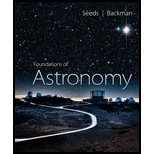
Foundations of Astronomy (MindTap Course List)
14th Edition
ISBN: 9781337399920
Author: Michael A. Seeds, Dana Backman
Publisher: Cengage Learning
expand_more
expand_more
format_list_bulleted
Question
Chapter 23, Problem 1LTL
To determine
The arrangements of orbits of moons relative to the plane of the planet’s equator and rings; whether it gives any information about the moons formation.
Expert Solution & Answer
Want to see the full answer?
Check out a sample textbook solution
Students have asked these similar questions
d
need help with the one i got wrong
Identify which of the following vectors are parallel to A.
Vector
Vector A
70°
60°
20°
AAZA!
30°
20°
20°
70°
20°
20°
70°
20°
Chapter 23 Solutions
Foundations of Astronomy (MindTap Course List)
Ch. 23 - Why didnt ancient astronomers know of Uranuss...Ch. 23 - Describe the location of the equinoxes and...Ch. 23 - When during Uranuss seasonal cycle does every...Ch. 23 - How were the rotation periods of Uranus and...Ch. 23 - Why is belt-zone circulation difficult to detect...Ch. 23 - Prob. 6RQCh. 23 - Prob. 7RQCh. 23 - Describe four characteristics in common among all...Ch. 23 - Describe four differences between the two ice...Ch. 23 - Prob. 10RQ
Ch. 23 - What are hypotheses for the origin of the rings of...Ch. 23 - How do the characteristics of Uranuss and Neptunes...Ch. 23 - If Uranus and Neptune had no satellites at all,...Ch. 23 - Why might the surface brightness of ring particles...Ch. 23 - Both Uranus and Neptune have a blue-green tint...Ch. 23 - How are the atmospheres of Earth and Triton...Ch. 23 - Prob. 17RQCh. 23 - When Neptune was discovered, how was its position...Ch. 23 - How can small worlds like Triton and Pluto have...Ch. 23 - Why do you suspect that Triton had a geologically...Ch. 23 - If you visited the surface of Pluto and found...Ch. 23 - What evidence can you give that Pluto and Charon...Ch. 23 - Why was Pluto reclassified as a dwarf planet?Ch. 23 - How was the discovery of Neptune not accidental?Ch. 23 - What is the maximum angular diameter of Uranus as...Ch. 23 - One way to recognize a distant planet is by...Ch. 23 - What is the orbital velocity of Miranda around...Ch. 23 - Calculate Uranuss Roche radius. Are all of Uranuss...Ch. 23 - Prob. 5PCh. 23 - What is the escape velocity from the surface of an...Ch. 23 - What is the difference in the orbital velocities...Ch. 23 - Repeat Problem 2 for Pluto. In other words,...Ch. 23 - Given the size of Tritons orbit (r = 355,000 km)...Ch. 23 - Uranus is about 26,000 km in radius, and its main...Ch. 23 - Neptune is about 50,000 km in diameter, and its...Ch. 23 - Prob. 1LTLCh. 23 - Prob. 2LTLCh. 23 - Compare the interior cutaway sketches of the four...Ch. 23 - Prob. 4LTLCh. 23 - Review Figure 21-11. Which molecules can Triton...Ch. 23 - The image to the left shows how Uranus would look...
Knowledge Booster
Learn more about
Need a deep-dive on the concept behind this application? Look no further. Learn more about this topic, physics and related others by exploring similar questions and additional content below.Similar questions
- 3aarrow_forward44 please help with the this.arrow_forward4a Which of the following values COULD NOT be a magnitude? Choose all that apply. 626 0 -0.806 8.63 -48.5 72 131 156 4b Px = -1248 & Py = 261. Determine P.P = Qx = -1540 & Qy = 375. Determine Q.Q = 4c. T = 1105 & Ty = 425. Determine the two possible values for Tx. 4d. Uy = -38. Which of the following COULD NOT be the value of U? Choose all that apply. 10 70 72 31 47 0 75 38 4e. R has a magnitude of 165. Which of the following COULD be Rx? Choose all that apply. 165 -171 155 0 -156 -165 172 -130arrow_forward
arrow_back_ios
SEE MORE QUESTIONS
arrow_forward_ios
Recommended textbooks for you
 Foundations of Astronomy (MindTap Course List)PhysicsISBN:9781337399920Author:Michael A. Seeds, Dana BackmanPublisher:Cengage Learning
Foundations of Astronomy (MindTap Course List)PhysicsISBN:9781337399920Author:Michael A. Seeds, Dana BackmanPublisher:Cengage Learning
 AstronomyPhysicsISBN:9781938168284Author:Andrew Fraknoi; David Morrison; Sidney C. WolffPublisher:OpenStax
AstronomyPhysicsISBN:9781938168284Author:Andrew Fraknoi; David Morrison; Sidney C. WolffPublisher:OpenStax

Foundations of Astronomy (MindTap Course List)
Physics
ISBN:9781337399920
Author:Michael A. Seeds, Dana Backman
Publisher:Cengage Learning


Astronomy
Physics
ISBN:9781938168284
Author:Andrew Fraknoi; David Morrison; Sidney C. Wolff
Publisher:OpenStax

Kepler's Three Laws Explained; Author: PhysicsHigh;https://www.youtube.com/watch?v=kyR6EO_RMKE;License: Standard YouTube License, CC-BY